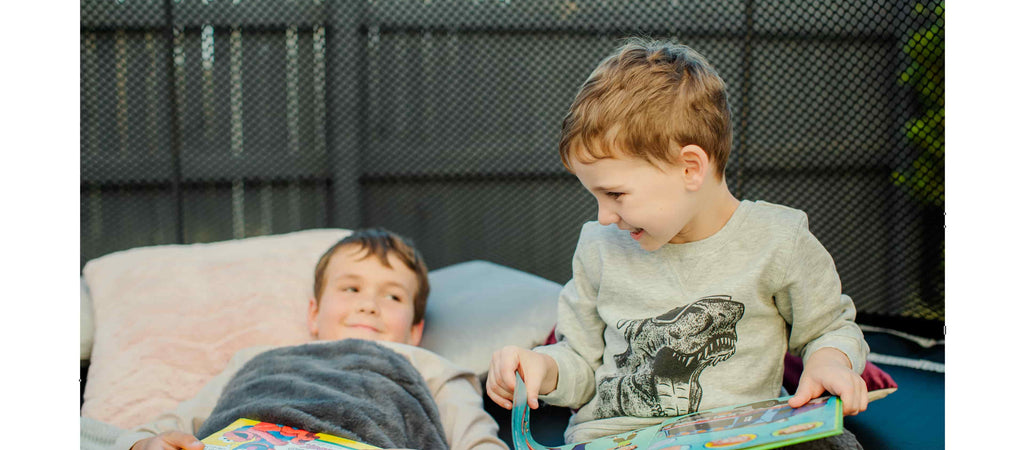10 Essential Back-to-School Tips for a Successful Year (2024)
Ease back into class with our 10 essential back-to-school tips! Perfect for parents and kids aiming for a seamless and successful school year.
min read

Another school year is upon us! That means it’s time for some much-needed back-to-school tips.
Transitioning back to school can be a mix of excitement and anxiety. Not just for students, but the entire family.
We’re going to make sure that you and your children are set up for a successful school year.
Whether you’re a seasoned parent or are sending your little one off to school for the first time, these tips will make the new school year seem seamless.
So, grab a cup of coffee (or whatever you prefer), take a deep breath and read on to start planning!
10 Back-to-School Tips for Success
Below are our best back-to-school tips, where you’ll find helpful information for students and parents.
1. Simplify School Supplies
Preparing for school can be difficult. Beyond buying uniforms, there’s a whole list of items you will need to get for classes. Here are some hacks to make these purchases easier!
Stationery Made Simple: Schools typically provide a ready-made stationery list through partners like Office Max. Just input your child's name and class to place your order! While it's tempting to try and save a few dollars by shopping for items individually, most parents agree it's more hassle than it's worth. Tip: Order in December and set delivery for January. This way, your child's supplies are sorted well before school starts.
Covering Books: Any parent who's experienced the stress of trying to cover books will be stoked to discover Spencil! They come in all exercise book sizes, in designs your kids will love. You simply slide books into them, and the added bonus is they can be reused.
BYOD (Bring Your Own Device):
BYOD (Bring Your Own Device), has become a requirement in schools starting around year 3 or 4. Given its significant cost, it's a decision that parents usually approach with thoughtful consideration. Check out this helpful article by Australian consumer group CHOICE: How to find the best tablet or laptop for school.
Starting School:
Preparing for your child's first day of school takes a fair amount of planning! Check out Starting school: preparing children by RaisingChildren.net.au.
2. Set Goals
Another thing to get accomplished before the first day is goal setting. What should your child strive for this year?
Of course, this is going to depend on your child’s age, grade level and interests.
We’ve broken down examples of goals you can set for your child based on age range:
Younger Kids (Primary School Students)
- Have your child read for at least 30 minutes each day.
- Complete a creative project (like drawing) at least once a week.
- Encourage your child to join at least one consistent after-school activity.
Older Kids/Preteens (Intermediate Students)
- Target a specific subject that they struggle with and aim to improve their grades from the previous year.
- Join at least one club, sports team or musical group to develop new skills and make friends.
- Consider volunteering a certain number of hours per semester. It looks great on your CV!
3. Establish a Steady Routine
A healthy routine is key, especially for young children in school.
Here is an example routine for inspiration, including nighttime, morning and after-school studying:
Night Prep (6:00 PM - 8:00 PM)
6:00 PM - 6:30 PM: Dinner time with family, emphasizing a balanced meal with vegetables, protein, and whole grains.
6:30 PM - 7:00 PM: After-dinner family activity, like a walk or trampoline game.
7:00 PM - 7:20 PM: Begin winding down with quieter activities, such as reading or puzzles, to signal the end of the day.
7:20 PM - 7:30 PM: Nightly hygiene routine including brushing teeth, washing face, and a warm bath if it's bath night.
7:30 PM - 7:45 PM: Quiet time in the bedroom, preparing clothes and school bag for the next day to reduce morning stress.
7:45 PM - 8:00 PM: Bedtime story or a calm discussion about the day, followed by lights out to ensure the child gets the recommended 9-11 hours of sleep.
Morning Routine (6:00 AM - 8:00 AM)
6:00 AM - 6:20 AM: Wake up and engage in a morning hygiene routine (brushing teeth and washing face.)
6:20 AM - 6:40 AM: Get dressed in the outfit picked out the night before.
6:40 AM - 7:00 AM: Enjoy a nutritious breakfast that includes a good balance of protein, whole grains, and fruit.
7:00 AM - 7:10 AM: Pack the lunchbox together, including last-minute items to ensure freshness.
7:10 AM - 7:30 AM: Review the day's schedule, including any after-school activities, to mentally prepare the child.
7:30 AM - 8:00 AM: Travel to school, whether it's by walking, cycling, or driving, making sure to leave with enough time to arrive calmly and without rush.
Study Habits (After School - 5:00 PM)
After School - 4:00 PM: Unwind with a snack and a brief period of outdoor play to transition from school to home.
4:00 PM - 4:15 PM: Set up the study space, ensuring it’s quiet, well-lit, and free from distractions.
4:15 PM - 4:45 PM: Homework time, with a focus on challenging tasks first while your child’s mind is fresh.
4:45 PM - 5:00 PM: Reading time to foster literacy and comprehension skills.

4. Prep Healthy School Lunches
It’s important for growing children to get proper nutrition.
A back-to-school nutrition tip we have for you is meal-prepping.
Prepping your meals can help provide your child with lunches for the whole week without the stress of making it the day of.
Action: Choose a Saturday or Sunday to prep your child’s lunches for the week.
If you need some inspiration or ideas, check out our lunchbox hacks!
5. Craft a Study Area
As working parents know, having a comfortable place to work is crucial for success.
It’s the same with children. In a warm and comfortable environment, children will be more motivated to get their work done – and maybe even enjoy it too!
We love this study area, courtesy of Pinterest:

6. Have a Safe Plan for Transportation
The start of the year is a good time to teach (or remind) children about road safety. RaisingChildren.net.au's article Pedestrian and road safety for children includes tips for safeyly getting in and out of the car, pedestrian safety, and understanding when your child is safe to go solo. A few of the key takeaways are:
- Always cross at the safest point, even if you have to walk further out of your way.
- Lead by example and put away phones and other devices when you’re walking around roads and cars.
- Stop at driveways and check there are no cars reversing or entering.
- Plan the best route that keeps your child off roads as much as possible.
7. Extracurricular Activities
Extracurricular activities are great for kids, boosting their social life, keeping them active, and sharpening their minds. They're fun ways for kids to discover what they love, make friends, and grow confidence. Plus, they teach valuable life skills like teamwork and time management. But picking the right mix of activities is a personal recipe, depending on what works for your family. Here's what to keep in mind:
-
Child's Age and Maturity: Mix it up for the little ones with different activities, and let the older kids dive deeper into what they really love.
-
Child’s Interests and Temperament: Match activities with what your child naturally enjoys, whether they're all about team sports or prefer quiet, creative time.
-
Family Schedule and Logistics: Find a sweet spot where activities fit comfortably into your family's routine without turning the calendar into a jigsaw puzzle. It's all about avoiding the rush and not stretching yourselves too thin, so family life stays more about fun and less about running from one thing to the next.
-
Financial Implications: Keep your budget happy by looking out for activities that won't break the bank.
-
Balance and Well-being: Make sure there's still plenty of time for your child to enjoy free play, rest, hang with the family, and just have fun being a kid!
-
Parental Involvement and Support: Check how much you'll need to be involved and make sure it's doable and positive for both you and your kid.
Keep the conversation going with your child to make sure they're having fun and not feeling the pressure. It's all about creating a supportive space for them to learn, grow, and most importantly, enjoy their childhood!
Here are examples of extracurricular activities for kids:
- Sports: Soccer, basketball, swimming, gymnastics, martial arts, tennis, golf, and dance.

- Arts: Painting, drawing, sculpture, photography, and crafting classes.
- Music: Learning to play instruments, singing in a choir, or joining a band.
- Drama: Participating in theater groups, drama clubs, or acting workshops.
- Languages: Language classes, such as Spanish, French, Mandarin, or sign language.
- Science and Tech: Robotics clubs, coding workshops, science fairs, or astronomy clubs.
- Literature: Book clubs, reading groups, or creative writing workshops.
- Environmental Clubs: Gardening, recycling projects, or nature exploration groups.
8. Ensure Medical Information and Emergency Contact Details are Up to Date
A sneaky-important back-to-school tip is to make sure your child’s medical information is updated, and check the emergency contacts the school has listed for your child are accurate.
This includes:
- Having a doctor on file.
- Informing the school of any medication your child may need during the school day.
- Letting the school know of any pre-existing medical conditions that might require support.
- Checking emergency contact details are up to date
9. Set Up Alerts from Your School
These days, most schools send updates through apps like Hero. Keeping up with school notices can feel like a job in itself for parents, so check that your notifications are turned on so you don't miss any important information.
10. Stay Positive
The school year can be stressful for children and parents alike.
During times of inevitable stress, it’s important to remain positive with your child.
Studies have shown that being positive can lead to better performance for children.
A study by the Stanford University School of Medicine found that positivity can lead to better math scores, increased memory and problem-solving enhancement.

Looking for a Healthy After-School Activity?
Getting back into the school routine can be challenging.
Hopefully, our back-to-school tips filled you with ideas and inspiration to make this school year the best one yet.
At Springfree Trampoline, providing children with the joy of playing outside is our essence.
We created the world’s safest Trampolines because we wanted children to experience the thrill of jumping without worrying about injuries.
Trampoline jumping yields many health benefits for kids of all ages, including:
- Improved heart health.
- Enhanced joint health.
- Balance and coordination development.
- Weight management.
- Improved focus and mood.
(Adults can benefit too!)
If you’re looking for a home activity for your child that gets them away from the screen, check out the benefits of Springfree Trampoline.


